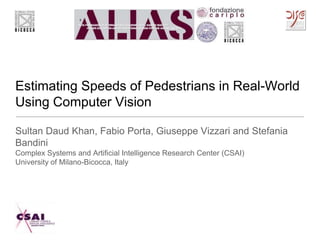
Analysing pedestrian dynamics with computer vision techniques - examples
- 1. Estimating Speeds of Pedestrians in Real-World Using Computer Vision Sultan Daud Khan, Fabio Porta, Giuseppe Vizzari and Stefania Bandini Complex Systems and Artificial Intelligence Research Center (CSAI) University of Milano-Bicocca, Italy
- 2. C&CA @ ACRI 2014 – Sept. 22, 2014 Outline • Crowd studies: towards integrated analysis and synthesis • Computer vision and crowd studies • Velocity estimation in naturalistic conditions • Crowd flow segmentation and counting • Identification of sources and sinks, towards pedestrian behaviour understanding
- 3. C&CA @ ACRI 2014 – Sept. 22, 2014 Outline • Crowd studies: towards integrated analysis and synthesis • Computer vision and crowd studies • Velocity estimation in naturalistic conditions • Crowd flow segmentation and counting • Identification of sources and sinks, towards pedestrian behaviour understanding
- 4. C&CA @ ACRI 2014 – Sept. 22, 2014 Motivations of crowd studies • Large events involving large number of people in relatively small spaces are periodically held all around the world (sports, expositions, festivals, etc.) • Public safety in high density crowds is potentially a big issue • Decision support for designers and crowd managers, both in planning and management phases, is highly desirable
- 5. C&CA @ ACRI 2014 – Sept. 22, 2014 Towards integrated analysis and synthesis of crowd phenomena
- 6. C&CA @ ACRI 2014 – Sept. 22, 2014 Outline • Crowd studies: towards integrated analysis and synthesis • Computer vision and crowd studies • Velocity estimation in naturalistic conditions • Crowd flow segmentation and counting • Identification of sources and sinks, towards pedestrian behaviour understanding
- 7. C&CA @ ACRI 2014 – Sept. 22, 2014 Computer vision and crowd studies • Relevant factors influencing choice of techniques • Crowd “types” • Structured (motion constrained by environmental structure, crowd management procedures, other rules) • Unstructured (little constraints to pedestrian movements) • Crowd density • Initially driven by surveillance and security (anomalous movements detection) • Recent interest in collaborating with modeling and simulation community • 1st IEEE Workshop on Modeling, Simulation and Visual Analysis of Large Crowds – ICCV 2011 • First International Workshop on Pattern Recognition and Crowd Analysis – ICPR 2012 Junior, Musse, Jung, Crowd Analysis Using Computer Vision Techniques IEEE Signal Processing Magazine, 2010
- 8. C&CA @ ACRI 2014 – Sept. 22, 2014 Current activities and results • Low-medium density situations • Velocity estimation in naturalistic conditions • High density situations • Crowd flow segmentation and counting • Identification of sources and sinks, towards pedestrian behaviour understanding
- 9. C&CA @ ACRI 2014 – Sept. 22, 2014 Outline • Crowd studies: towards integrated analysis and synthesis • Computer vision and crowd studies • Velocity estimation in naturalistic conditions • Crowd flow segmentation and counting • Identification of sources and sinks, towards pedestrian behaviour understanding
- 10. C&CA @ ACRI 2014 – Sept. 22, 2014 Initial tracking approach • Frame enhancement and foreground segmentation • Tracking with KLT after corner detection
- 11. C&CA @ ACRI 2014 – Sept. 22, 2014 Velocity estimation in side view scenarios • Pixel to metric coordinates conversion approach based on the idea of scaling factors • Only applicable to limited kind of scenario • Requires coordinates of two points per considered path
- 12. C&CA @ ACRI 2014 – Sept. 22, 2014 Velocity estimation through homography • Alternative and more applicable (not limited to analysis of linear paths) approach to conversion between pixel and metric coordinates • Requires coordinates of four points in the analyzed scene
- 13. C&CA @ ACRI 2014 – Sept. 22, 2014 Tracking with the GMPC approach4 Amir Roshan Zamir, Afshin Dehghan, Mubarak Shah Human Detection GMCP Tracklet Generator GMCP Trajectory Generator Detected HumansInput Video Tracklets Trajectories Fig. 2. The block diagram of the proposed human tracking method term. In principle, it’s difficult to model the motion of one person for a long du- ration without having the knowledge of the destination, structure of the scene, interactions between people, etc. However, the motion can be modeled suffi- ciently using constant velocity or acceleration models over a short period of time. Therefore, the way motion is incorporated into the global data association process should be di↵erent in short and long terms. This motivated us to employ the hierarchical approach, i.e. finding tracklets first and then merging them into full trajectories. The rest of this section is organized as follows: 2.1 explains the proposed method for finding tracklets along with an overview of Generalized Minimum Clique Problem, our global motion-cost model and occlusion handling method. Merging the tracklets to form global trajectories is explained in 2.2. Zamir, Dehghan, Shah: GMCP- Tracker: Global Multi-object Tracking Using Generalized Minimum Clique Graphs. ECCV (2) 2012: 343-356
- 14. C&CA @ ACRI 2014 – Sept. 22, 2014 Outline • Crowd studies: towards integrated analysis and synthesis • Computer vision and crowd studies • Velocity estimation in naturalistic conditions • Crowd flow segmentation and counting • Identification of sources and sinks, towards pedestrian behaviour understanding
- 15. C&CA @ ACRI 2014 – Sept. 22, 2014 Crowd flow segmentation and counting
- 16. C&CA @ ACRI 2014 – Sept. 22, 2014 Outline • Crowd studies: towards integrated analysis and synthesis • Computer vision and crowd studies • Velocity estimation in naturalistic conditions • Crowd flow segmentation and counting • Identification of sources and sinks, towards pedestrian behaviour understanding
- 17. C&CA @ ACRI 2014 – Sept. 22, 2014 Identification of sources and sinks
- 18. C&CA @ ACRI 2014 – Sept. 22, 2014 Towards pedestrian behaviour understanding
- 19. C&CA @ ACRI 2014 – Sept. 22, 2014 Conclusions • Modeling and simulation studies need different types of data for calibration, validation, but also for the initial configuration of plausible simulations • Computer vision approaches can offer several solutions to these requirements and needs • The jargons, goals, perception of research challenges is not necessarily shared... • ... working together, possibly in joint projects, can surely improve the situation and achieved results
